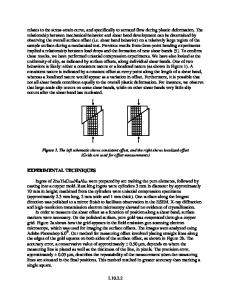Observations of adiabatic shear band formation in 7039 aluminum alloy
- PDF / 1,829,590 Bytes
- 4 Pages / 594 x 774 pts Page_size
- 97 Downloads / 451 Views
REFERENCES 1. S . M . L . Sastry, T.C. Peng, P.J. Meschter, and J. E. O'Neal: J. of Metals, 1983, vol. 35, pp. 21-28. 2. S. M. L. Sastry, P. J. Meschter, and J. E. O'Neal: Metall. Trans. A, 1984, vol. 15A, pp. 1451-63. 3. S . M . L . Sastry, T. C. Peng, and L. P. Beckerman: Metall. Trans. A, 1984, vol. 15A, pp. 1465-74. 4. J.E. O'Neal, T.C. Peng, and S. M. L. Sastry: Proc. of the Electron Microscopy Society of America, G.W. Bailey, ed., Claitor's Publishing Div., Baton Rouge, LA, 1981, pp. 66-67. 5. S . M . L . Sastry, T. C. Peng, J. E. O'Neal, and L. P. Beckerman: Proc.
of Third Conference on Rapid Solidification Processing: Principles and Technologies, R. Mehrabian and J. R. Manning, eds., Claitor's Publishing Div., Baton Rouge, LA, 1983, pp. 579-84. 6. R.E. Peebles and C. A. Kelto: Powder Metallurgy of Titanium Alloys, E H. Froes and J. E. Smugeresky, eds., TMS-AIME, Warrendale, PA, 1980, pp. 47-58. 7. R.R. Vaughn and P. A. Blenkenson: ibid., pp. 83-92. 8. P.R. Roberts and P. Lowenstein: ibid., pp. 21-35. 9. J.P. Laughlin and G.J. Dooley: III, ibid., pp. 37-46. 10. J. Devillard and J. P. Herteinan: ibid., pp. 59-70. 11. D.G. Konitzer, K. W. Waiters, E. L. Heiser, and H. L. Fraser: Metall. Trans. B, 1984, vol. 15B, pp. 149-53. 12. T.C. Peng, S. M. L. Sastry, J. E. O'Neal, and J. E Tesson: Application of Lasers in Materials Processing, E. A. Metzbower, ed., ASM, Metals Park, OH, 1983, pp. 241-46. 13. H. Schmitt: Powder Metallurgy International, 1979, vol. 11, pp. 17-21. 14. Handbook of Chemistry and Physics, 63rd ed., R.C. Locast, ed., Chemical Rubber Co. Press, Inc., Boca Raton, FL, 1982, p. F-28.
space-time morphology of important physical quantities within such an instability. 1However, metallographic studies in impacted steels show that the disturbed structure within the shear zone is transitional in nature, distinguishing between "deformed" bands consisting of heavily sheared initial microstructure and the white etching "transformed" bands characterized by greater shear concentration and by an absence of resolvable microstructural features. 2'3 The occurrence of "transformed" bands is dependent on alloy hardness and the degree of refinement of initial microstructure. 4'5 Recent ballistic studies in titanium alloys suggest that a similar classification of adiabatic shear bands may also apply in non-ferrous alloys. 6 This communication presents observations of adiabatic shear band formation in 7039 aluminum alloy as a function of aging time (and hence alloy hardness). Shear bands were produced by the impact of a flat ended projectile (4.76 mm in diameter) with 9.5 mm thick plate at normal incidence, the sharp edges of the projectile acting as sites for shear band initiation. 7'8 Comparison is also made with the impact of a semi-infinite target* (30 mm *A semi-infinite target exhibits no influence of the distal boundary on the penetration process. 9
thickness) of the same alloy. Target plates of 7039 aluminum alloy (4.0 pct Zn, 2.1 pct Mg, 0.28 pct Mn, 0.24 pct Fe, 0.12 pct Si) were solution treated at 482 ~
Data Loading...











